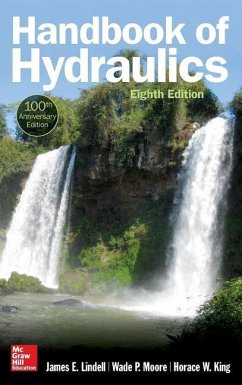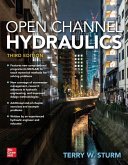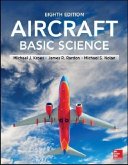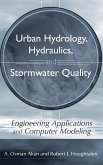- Gebundenes Buch
- Merkliste
- Auf die Merkliste
- Bewerten Bewerten
- Teilen
- Produkt teilen
- Produkterinnerung
- Produkterinnerung
Publisher's Note: Products purchased from Third Party sellers are not guaranteed by the publisher for quality, authenticity, or access to any online entitlements included with the product. Fully Updated Hydraulics Engineering Concepts, Methods, and Practices This thoroughly revised resource offers comprehensive coverage of every aspect of hydraulics. Handbook of Hydraulics, Eighth Edition, features the latest data and computational modeling techniques and clearly explains cutting-edge methods, processes, and technologies. You will get more than 80 dependable tables and graphs, sample…mehr
Andere Kunden interessierten sich auch für
![Open Channel Hydraulics, Third Edition Open Channel Hydraulics, Third Edition]() Terry W SturmOpen Channel Hydraulics, Third Edition136,99 €
Terry W SturmOpen Channel Hydraulics, Third Edition136,99 €![Design of Wood Structures- Asd/Lrfd, Eighth Edition Design of Wood Structures- Asd/Lrfd, Eighth Edition]() Donald E BreyerDesign of Wood Structures- Asd/Lrfd, Eighth Edition104,99 €
Donald E BreyerDesign of Wood Structures- Asd/Lrfd, Eighth Edition104,99 €![Environmental Hydraulics, 5 Volume Set Environmental Hydraulics, 5 Volume Set]() Environmental Hydraulics, 5 Volume Set1.098,99 €
Environmental Hydraulics, 5 Volume Set1.098,99 €![Stormwater Collection Systems Design Handbook Stormwater Collection Systems Design Handbook]() Larry W MaysStormwater Collection Systems Design Handbook170,99 €
Larry W MaysStormwater Collection Systems Design Handbook170,99 €![Aircraft Basic Science, Eighth Edition Aircraft Basic Science, Eighth Edition]() Michael J. KroesAircraft Basic Science, Eighth Edition130,99 €
Michael J. KroesAircraft Basic Science, Eighth Edition130,99 €![Urban Hydrology, Hydraulics, and Stormwater Quality Urban Hydrology, Hydraulics, and Stormwater Quality]() Osman AkanUrban Hydrology, Hydraulics, and Stormwater Quality175,99 €
Osman AkanUrban Hydrology, Hydraulics, and Stormwater Quality175,99 €![Biology of Wastewater Treatment (2nd Edition) Biology of Wastewater Treatment (2nd Edition)]() Nicholas F GrayBiology of Wastewater Treatment (2nd Edition)463,99 €
Nicholas F GrayBiology of Wastewater Treatment (2nd Edition)463,99 €-
-
-
Publisher's Note: Products purchased from Third Party sellers are not guaranteed by the publisher for quality, authenticity, or access to any online entitlements included with the product. Fully Updated Hydraulics Engineering Concepts, Methods, and Practices This thoroughly revised resource offers comprehensive coverage of every aspect of hydraulics. Handbook of Hydraulics, Eighth Edition, features the latest data and computational modeling techniques and clearly explains cutting-edge methods, processes, and technologies. You will get more than 80 dependable tables and graphs, sample equations, and real-world examples. This single source for on-the-job hydraulics engineering information will save time and ensure accuracy in performing hydraulic calculations. Coverage includes: ¿Fluid properties and hydraulic units ¿Hydrostatics ¿Fundamental concepts of fluid flow ¿Orifices, gates, and valves ¿Weirs ¿Pipes ¿Steady uniform flow in open channels ¿Open channels with non-uniform flow ¿High-velocity transitions ¿Wave motion and forces ¿Spatially variable and unsteady flow ¿Measurement of flowing water ¿Computational hydraulics ¿Physical and mathematical modeling of hydraulic structures
Produktdetails
- Produktdetails
- Verlag: McGraw Hill LLC
- 8th edition
- Seitenzahl: 416
- Erscheinungstermin: 11. Oktober 2017
- Englisch
- Abmessung: 231mm x 150mm x 25mm
- Gewicht: 440g
- ISBN-13: 9781259859687
- ISBN-10: 1259859681
- Artikelnr.: 48917590
- Herstellerkennzeichnung
- Libri GmbH
- Europaallee 1
- 36244 Bad Hersfeld
- gpsr@libri.de
- Verlag: McGraw Hill LLC
- 8th edition
- Seitenzahl: 416
- Erscheinungstermin: 11. Oktober 2017
- Englisch
- Abmessung: 231mm x 150mm x 25mm
- Gewicht: 440g
- ISBN-13: 9781259859687
- ISBN-10: 1259859681
- Artikelnr.: 48917590
- Herstellerkennzeichnung
- Libri GmbH
- Europaallee 1
- 36244 Bad Hersfeld
- gpsr@libri.de
McGraw-Hill authors represent the leading experts in their fields and are dedicated to improving the lives, careers, and interests of readers worldwide
Preface to the Eighth Edition Preface to the First Edition Section 1 Fluid Properties and Hydraulic Units Fluid Properties Hydraulic Units Reference Section 2 Hydrostatics Fluid Pressure Atmospheric Pressure Manometers Pressure Forces on Plane Surfaces Pressure Forces on Curved Surfaces Uniform Pressure on Cylindrical Surfaces Uniform Pressure on Spherical Surfaces Pressures on Spillway Sections of Dams Uplift Pressure on Dams Stability of Dams References Section 3 Fundamental Concepts of Fluid Flow Classification of Flow Continuity Energy and the Bernoulli Equation Siphons Venturi Meters Cavitation Momentum Concepts Dimensional Analysis and Similitude References Section 4 Orifices, Gates, and Tubes Fundamental Equations Path of Jet Orifices under Low Heads Discharge under Falling Head Orifice Coefficients Submerged Orifices Gates Pipe Orifices Tubes Standard Short Tubes Nozzles Submerged Tubes Culverts References Section 5 Weirs Fundamental Principles Sharp-Crested Weirs Horizontal Sharp-Crested Weirs with L/b = 1 Horizontal Sharp-Crested Weirs with End Contractions V-Notch Weirs Submerged Sharp-Crested Weirs Weirs Not Sharp-Crested Broad-Crested Weirs Weirs of Triangular Section Weirs of Trapezoidal Section Weirs of Irregular Section Spillway Sections Selection and Use of Weirs Weirs for Measuring Stream Flow References Section 6 Pipes Fundamental Principles Loss of Energy due to Friction Laminar Flow in Pipes Turbulent Flow in Pipes Selection of Energy-Loss Equation and Friction Factor Minor Losses Loss at Entrance Loss of Head due to Enlargement Loss of Head due to Contraction Loss of Head due to Gate Valves Loss of Head due to Bends Compound Pipes Distribution Networks Hardy Cross Solution Nodal Method References Section 7 Steady Uniform Flow in Open Channels Elements of a Cross Section Sectional Forms Most Efficient Channel Section Energy Losses in Open Channels Laminar Flow with Free Surface Turbulent Flows in Open Channels The Manning Equation Roughness Coefficients Noneroding Velocities Air Entrainment References Section 8 Open Channels with Nonuniform Flow Rapidly Varied Flow Constant-Discharge Relations Constant-Energy Relations Analytical Solutions of Constriction Problems Critical Depth-General Case Critical Depth in Rectangular Channels Critical Depth in Triangular Channels Critical Depth in Trapezoidal Sections Critical Depth in Circular Channels Critical-Depth Meters Critical Slope Channel Entrance Free Outfall Hydraulic Jump Hydraulic Jump for Small Slopes Force Equation Hydraulic-Jump Computations Hydraulic Jump in Trapezoidal Channels Hydraulic Jump in Rectangular Channels Hydraulic Jump in Sloping Channels Length of Jump Position of Jump Minor Losses Transition through Critical Depth without Jump Gradually Varied Flow Equations of Gradually Varied Flow and Generalized Profiles Methods of Computing Water-Surface Profiles Short Channels Chutes Flow over Very Steep Inclines References Section 9 High-Velocity Transitions Straight-Walled Constrictions Enlargements and Curved-Wall Constrictions Method of Characteristics High-Velocity Flow at Channel Bends References Section 10 Wave Motion and Forces Oscillatory Waves Surface Form Wave Celerity Wavelength Orbital Motion Group Velocity and Energy Transmission Refraction Variation of Wave Height with Depth Breaking Waves Characteristics of Wind-Generated Waves Wave Run-Up and Overtopping Wave Forces Wave Forces on Piling and Submerged Structures Wind Tides Translatory Waves Positive Waves Negative Waves References Section 11 Spatially Variable and Unsteady Flow Unsteady Open-Channel Flow Steady Spatially Variable Flow Unsteady Flow with Free Surface Water Hammer Pressure When T
2L/
Pressure When T
2L/
References Section 12 Measurement of Flowing Water Current Meter Pitot Tube Color Method Salt-Velocity Method Gibson Method Venturi Meter Pipe Orifice Standardized Nozzles California-Pipe Method Venturi Flume Critical-Depth Meter Contracted Opening Chemical Gauging Electromagnetic Flowmeters References Section 13 Computational Hydraulics Elementary Computational Concepts Solution by Successive Approximations Steady Nonuniform Flow in Prismatic Open Channels Steady Flow in Pipes Experimental Measurements-Least-Squares Analysis Unsteady Flow in Pipes and Open Channels Advanced Numerical Methods Finite-Difference Method Finite-Element Method References Section 14 Physical and Mathematical Modeling of Hydraulic Structures Introduction Composite Modeling Physical Modeling Overview Numerical Modeling Overview Composite Modeling Overview Summary and Conclusions References Index
2L/
Pressure When T
2L/
References Section 12 Measurement of Flowing Water Current Meter Pitot Tube Color Method Salt-Velocity Method Gibson Method Venturi Meter Pipe Orifice Standardized Nozzles California-Pipe Method Venturi Flume Critical-Depth Meter Contracted Opening Chemical Gauging Electromagnetic Flowmeters References Section 13 Computational Hydraulics Elementary Computational Concepts Solution by Successive Approximations Steady Nonuniform Flow in Prismatic Open Channels Steady Flow in Pipes Experimental Measurements-Least-Squares Analysis Unsteady Flow in Pipes and Open Channels Advanced Numerical Methods Finite-Difference Method Finite-Element Method References Section 14 Physical and Mathematical Modeling of Hydraulic Structures Introduction Composite Modeling Physical Modeling Overview Numerical Modeling Overview Composite Modeling Overview Summary and Conclusions References Index
Preface to the Eighth Edition Preface to the First Edition Section 1 Fluid Properties and Hydraulic Units Fluid Properties Hydraulic Units Reference Section 2 Hydrostatics Fluid Pressure Atmospheric Pressure Manometers Pressure Forces on Plane Surfaces Pressure Forces on Curved Surfaces Uniform Pressure on Cylindrical Surfaces Uniform Pressure on Spherical Surfaces Pressures on Spillway Sections of Dams Uplift Pressure on Dams Stability of Dams References Section 3 Fundamental Concepts of Fluid Flow Classification of Flow Continuity Energy and the Bernoulli Equation Siphons Venturi Meters Cavitation Momentum Concepts Dimensional Analysis and Similitude References Section 4 Orifices, Gates, and Tubes Fundamental Equations Path of Jet Orifices under Low Heads Discharge under Falling Head Orifice Coefficients Submerged Orifices Gates Pipe Orifices Tubes Standard Short Tubes Nozzles Submerged Tubes Culverts References Section 5 Weirs Fundamental Principles Sharp-Crested Weirs Horizontal Sharp-Crested Weirs with L/b = 1 Horizontal Sharp-Crested Weirs with End Contractions V-Notch Weirs Submerged Sharp-Crested Weirs Weirs Not Sharp-Crested Broad-Crested Weirs Weirs of Triangular Section Weirs of Trapezoidal Section Weirs of Irregular Section Spillway Sections Selection and Use of Weirs Weirs for Measuring Stream Flow References Section 6 Pipes Fundamental Principles Loss of Energy due to Friction Laminar Flow in Pipes Turbulent Flow in Pipes Selection of Energy-Loss Equation and Friction Factor Minor Losses Loss at Entrance Loss of Head due to Enlargement Loss of Head due to Contraction Loss of Head due to Gate Valves Loss of Head due to Bends Compound Pipes Distribution Networks Hardy Cross Solution Nodal Method References Section 7 Steady Uniform Flow in Open Channels Elements of a Cross Section Sectional Forms Most Efficient Channel Section Energy Losses in Open Channels Laminar Flow with Free Surface Turbulent Flows in Open Channels The Manning Equation Roughness Coefficients Noneroding Velocities Air Entrainment References Section 8 Open Channels with Nonuniform Flow Rapidly Varied Flow Constant-Discharge Relations Constant-Energy Relations Analytical Solutions of Constriction Problems Critical Depth-General Case Critical Depth in Rectangular Channels Critical Depth in Triangular Channels Critical Depth in Trapezoidal Sections Critical Depth in Circular Channels Critical-Depth Meters Critical Slope Channel Entrance Free Outfall Hydraulic Jump Hydraulic Jump for Small Slopes Force Equation Hydraulic-Jump Computations Hydraulic Jump in Trapezoidal Channels Hydraulic Jump in Rectangular Channels Hydraulic Jump in Sloping Channels Length of Jump Position of Jump Minor Losses Transition through Critical Depth without Jump Gradually Varied Flow Equations of Gradually Varied Flow and Generalized Profiles Methods of Computing Water-Surface Profiles Short Channels Chutes Flow over Very Steep Inclines References Section 9 High-Velocity Transitions Straight-Walled Constrictions Enlargements and Curved-Wall Constrictions Method of Characteristics High-Velocity Flow at Channel Bends References Section 10 Wave Motion and Forces Oscillatory Waves Surface Form Wave Celerity Wavelength Orbital Motion Group Velocity and Energy Transmission Refraction Variation of Wave Height with Depth Breaking Waves Characteristics of Wind-Generated Waves Wave Run-Up and Overtopping Wave Forces Wave Forces on Piling and Submerged Structures Wind Tides Translatory Waves Positive Waves Negative Waves References Section 11 Spatially Variable and Unsteady Flow Unsteady Open-Channel Flow Steady Spatially Variable Flow Unsteady Flow with Free Surface Water Hammer Pressure When T
2L/
Pressure When T
2L/
References Section 12 Measurement of Flowing Water Current Meter Pitot Tube Color Method Salt-Velocity Method Gibson Method Venturi Meter Pipe Orifice Standardized Nozzles California-Pipe Method Venturi Flume Critical-Depth Meter Contracted Opening Chemical Gauging Electromagnetic Flowmeters References Section 13 Computational Hydraulics Elementary Computational Concepts Solution by Successive Approximations Steady Nonuniform Flow in Prismatic Open Channels Steady Flow in Pipes Experimental Measurements-Least-Squares Analysis Unsteady Flow in Pipes and Open Channels Advanced Numerical Methods Finite-Difference Method Finite-Element Method References Section 14 Physical and Mathematical Modeling of Hydraulic Structures Introduction Composite Modeling Physical Modeling Overview Numerical Modeling Overview Composite Modeling Overview Summary and Conclusions References Index
2L/
Pressure When T
2L/
References Section 12 Measurement of Flowing Water Current Meter Pitot Tube Color Method Salt-Velocity Method Gibson Method Venturi Meter Pipe Orifice Standardized Nozzles California-Pipe Method Venturi Flume Critical-Depth Meter Contracted Opening Chemical Gauging Electromagnetic Flowmeters References Section 13 Computational Hydraulics Elementary Computational Concepts Solution by Successive Approximations Steady Nonuniform Flow in Prismatic Open Channels Steady Flow in Pipes Experimental Measurements-Least-Squares Analysis Unsteady Flow in Pipes and Open Channels Advanced Numerical Methods Finite-Difference Method Finite-Element Method References Section 14 Physical and Mathematical Modeling of Hydraulic Structures Introduction Composite Modeling Physical Modeling Overview Numerical Modeling Overview Composite Modeling Overview Summary and Conclusions References Index








